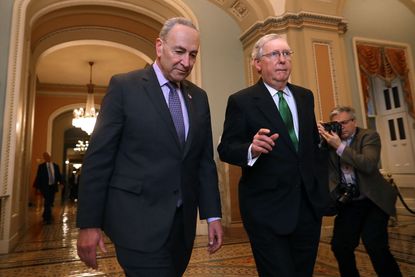Congress approves 2-year budget deal, all but ending short-lived government shutdown


On Friday morning, the House narrowly approved a bipartisan two-year budget deal, 240-186, with Democratic votes needed to overcome a revolt by fiscal conservatives in the majority Republican caucus. The Senate passed the bill earlier Friday morning, 71-28, but not before the government shut down at midnight. Once President Trump signs the bill, the short-lived and unexpected shutdown will be over. Sen. Rand Paul (R-Ky.) proudly took the blame for this shutdown, throwing up procedural hurdles on Thursday night to protest the legislation's surge in deficit spending — the bill adds roughly $320 billion to the federal deficit.
The legislation raises budget caps on military and domestic spending, adds $90 billion for hurricane and wildfire recovery, extends $17 billion in business tax breaks, authorizes infrastructure and opioid-fighting spending, and renews several large health-care programs. It does not include protections for DREAMers, or young immigrants brought to the U.S. illegally as children, as House Democrats had hoped. The legislation only funds the government until March 23, at which point Congress will have to pass what lawmakers hope is the final spending bill of fiscal 2018.
Sign up for Today's Best Articles in your inbox
A free daily email with the biggest news stories of the day – and the best features from TheWeek.com
Subscribe to The Week
Escape your echo chamber. Get the facts behind the news, plus analysis from multiple perspectives.

Sign up for The Week's Free Newsletters
From our morning news briefing to a weekly Good News Newsletter, get the best of The Week delivered directly to your inbox.
From our morning news briefing to a weekly Good News Newsletter, get the best of The Week delivered directly to your inbox.
Peter has worked as a news and culture writer and editor at The Week since the site's launch in 2008. He covers politics, world affairs, religion and cultural currents. His journalism career began as a copy editor at a financial newswire and has included editorial positions at The New York Times Magazine, Facts on File, and Oregon State University.
-
 Inside the house of Assad
Inside the house of AssadThe Explainer Bashar al-Assad and his father, Hafez, ruled Syria for more than half a century but how did one family achieve and maintain power?
By The Week UK Published
-
 Sudoku medium: December 22, 2024
Sudoku medium: December 22, 2024The Week's daily medium sudoku puzzle
By The Week Staff Published
-
 Crossword: December 22, 2024
Crossword: December 22, 2024The Week's daily crossword
By The Week Staff Published
-
 Judges block $25B Kroger-Albertsons merger
Judges block $25B Kroger-Albertsons mergerSpeed Read The proposed merger between the supermarket giants was stalled when judges overseeing two separate cases blocked the deal
By Peter Weber, The Week US Published
-
 Rupert Murdoch loses 'Succession' court battle
Rupert Murdoch loses 'Succession' court battleSpeed Read Murdoch wanted to give full control of his empire to son Lachlan, ensuring Fox News' right-wing editorial slant
By Peter Weber, The Week US Published
-
 Bitcoin surges above $100k in post-election rally
Bitcoin surges above $100k in post-election rallySpeed Read Investors are betting that the incoming Trump administration will embrace crypto
By Peter Weber, The Week US Published
-
 Enron mystery: 'sick joke' or serious revival?
Enron mystery: 'sick joke' or serious revival?Speed Read 23 years after its bankruptcy filing, the Texas energy firm has announced its resurrection
By Peter Weber, The Week US Published
-
 US charges Indian tycoon with bribery, fraud
US charges Indian tycoon with bribery, fraudSpeed Read Indian billionaire Gautam Adani has been indicted by US prosecutors for his role in a $265 million scheme to secure solar energy deals
By Peter Weber, The Week US Published
-
 Boeing machinists approve contract, end strike
Boeing machinists approve contract, end strikeSpeed Read The company's largest union approved the new contract offer, ending a seven-week strike
By Peter Weber, The Week US Published
-
 US economy still strong in final preelection report
US economy still strong in final preelection reportSpeed Read It grew at a solid 2.8% annual rate from July through September
By Peter Weber, The Week US Published
-
 Boeing machinists reject deal, continue strike
Boeing machinists reject deal, continue strikeSpeed Read The rejection came the same day Boeing reported a $6.2 billion quarterly loss
By Peter Weber, The Week US Published